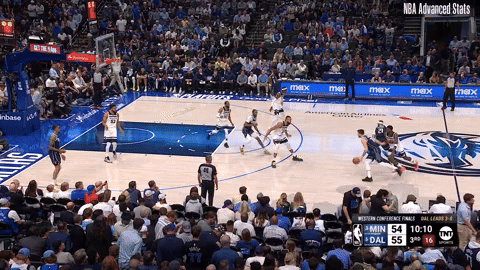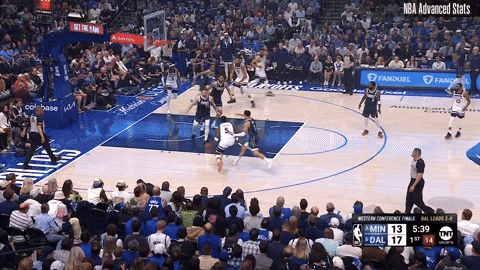3 x 3 x 3 on the Dallas Mavericks
3 things on Dallas' offense. For the next 3 days.
Two more days. Two more sleeps until the NBA Finals begin. I’m not going to lie. I’ve enjoyed the break between the Eastern Conference Finals and the start of the NBA Finals. An NBA season is long. Covering the team for multiple outlets is fun but tough. The additional ‘me’ time was much needed.
This point of the season is always nerve-wracking. As a fan, I want to see the team I love finally get over the hump. I remember their last championship run. I remember where I was, what I was wearing, and how that put me on the path I currently find myself on today. Like all of you reading this, I want to experience that again.
From a professional standpoint, the NBA Finals comes with some challenges — at least for me. Being so far away, with a significant time difference, I have to pick and choose the games I watch outside of the Celtics. I watch every C’s game at least twice. I go back and clip plays. I pull possessions I want to learn from. Before I know it, there’s another game to dive into.
I keep up with the Eastern Conference. That’s where most of the Celtics threats are — because you’ve got to navigate the East to get to the NBA Finals. I keep up with the Golden State Warriors because I do some work covering the team for USA Today. And then, I choose one or two teams to stay locked in on throughout the year. Dallas has not been one of those teams.
So, while enjoying additional downtime, I’ve been trying to finish some film work. I could have done more. I could have done less, but there’s always a happy medium to be found.
I’ve been toying with the idea of breaking down previous Mavericks games. That felt like the most logical approach. Yet, for some reason, that didn’t seem like the fun way to dive into the team. Yes, I’ve got to watch the games. No, I don’t need to write up post-game analysis pieces of things that happened last week, last month, or even last year, depending on how far back I wanted to go.
So, I came up with this 3 x 3 x 3 idea. So, for the next 3 days, I will give you 3 things I’ve spotted from the Mavericks offense. 3 things I’ve spotted from the Mavericks defense. And 3 things that pop out to me from the Mavericks’ overall approach.
Today, we focus on offense.
I feel like that’s more digestible. It’s ‘snackable.’ And it’s more fun to write that way.
Each segment will be broken down into 3 areas — see the theme here? — the what, the why, and the how…to defend or attack.
3 things on offense
Luka Doncic’s late lobs
The what: A late lob is exactly what it says on the tin. It’s a lob pass that’s thrown late in the play when the defense is set up to guard a drive or jumper.
Aside from the lob threat, a play is developing. Someone is penetrating, cutting or coming off a screen — it doesn’t matter what’s happening; the point is, something is keeping the defense locked in elsewhere on the floor. Then, as the shot threat emerges, a lob is thrown out of nowhere, catching the defense off guard as they look to close out on the perceived shooting threat.
Doncic is the Obi-Wan of the late lob. The Dumbledore. The Morpheus. The Professor Xavier. The Zordon. The Professor Oak. Catch my drift? He’s really, really good.
The clip above is a strong example of a late lob. Doncic comes off the drag screen and threatens to attack the rim. He varies his pace. He stutter steps. He slot drives toward the paint. The Minnesota Timberwolves collapse around him. At the point when his feet leave the ground, you can count four defensive bodies in his vicinity.
Doncic’s body positioning and movement scream that he’s looking to get a floater off. He gets the ball to his strong hand. He enters his gather step. He’s looking at the bucket. Then, as the defense gears up to pressure the shot, Doncic flips his angle and hits the lob pass.
Minnesota is caught off guard. Nobody is boxing out on Daniel Gafford. He’s left to catch and finish the play with no resistance.
Here’s another example. This time, the play occurs in transition. Watch how Dereck Lively II runs the floor, positioning himself straight into the weakside dunker spot. Doncic shows no sign of looking for his rim-running big man. Instead, he flows into a high post-up and begins to back his man down.
As Doncic spins to face up and threatens to lean into a fadeaway jumper, he draws Rudy Gobert out of the paint, with the Timberwolves shot-blocker looking to do what he does best. The problem is that Lively is now all alone in the dunker spot. Doncic spots his man, sees he’s drawn help, and his fadeaway is now a jump pass toward the rim. Boom. Lob.
The Celtics Chronicle is a reader-supported publication. To receive new posts and support my work, consider becoming a free or paid subscriber.
The why: These actions work because of the gravity Doncic commands. When facing teams that send two or three to the ball, Doncic can attack his spots, knowing that someone will be open around the rim or cutting ‘middle.’
Second-side actions are often designed to attack a defense that has shifted over. The more you can force the defense to rotate, the more gaps you will find on a possession-by-possession basis. Doncic is using that principle and manipulating it to complement his gravitational pull. As the defense shifts, he goes into a shooting motion before swinging the ball toward the weakside, where a scoring threat is lying in wait.
It’s not exactly a second-side action, but with the late lob play, Doncic has developed those principles to create and exploit gaps. The more help you send, the more options he will have near the rim. The closer you let him get to the paint, the easier the pass will be to spot and make. And if you close out too soon, he can step through and put the rock right above the rim.
Lob plays have always been easy money. Adding gravity, scoring threat, and misdirection into the build-up makes it incredibly tough for a defense to read what’s happening and react accordingly.
The how: As with anything a superstar does, there’s no guaranteed way to stop it. However, the most logical answer would be to resist the urge to send help. The Celtics rarely put two on the ball. They rarely look to double-team. They do, however, like to help and recover. Doncic will undoubtedly try to exploit those fleeting moments if he can spot a lob threat.
Nevertheless, the Celtics must stick to their defensive principles. If they can instruct Kristaps Porzingis or Al Horford to avoid being drawn toward Doncic and to guard their yard, there should be a consistent body protecting the rim. Dallas’ late lob plays work when the big has been drawn away, and there’s somebody open within four feet of the basket.
Porzingis has been the beneficiary of Doncic’s late lobs in the past. He will know what to expect and perhaps even what to look for. Still, figuring out how to limit the impact of the late lob could shave four to six points off the Mavericks scoring totals. Every little helps.
The rest of this post is for paid subscribers. The limited-time 40% special offer on annual plans (for your first year) is still live but will expire before the opening game of the NBA Finals. You can grab a bargain by clicking on the button below.




